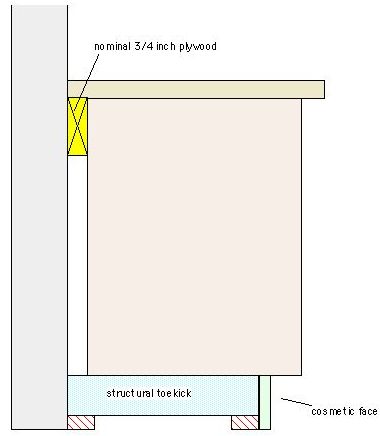Question
I usually make base cabinet depths 23 3/4" (24 1/2" with the door) and I'm thinking of making them 23" deep instead, because since I put end panels on finished sides, I can cut the panels at 23 3/4" and get better stock yield than cutting at 24 3/4". How will this affect sink cabinets and wall oven cabinets? The kitchen I'm about to start will have a wall oven which is exactly 23" in recessed depth. Will I always be on the safe side making boxes 23"deep?
Forum Responses
(Cabinetmaking Forum)
From contributor D:
No, not really. Industry standards are there for a pretty good reason. Sinks, stoves, ranges, ovens, dishwashers, compactors have been largely based off of 24". A standard countertop around here is about 25 1/2" deep. You would be asking for nothing but trouble.
On those projects we would gun nail a strip of plywood around the perimeter of the room, fastening it to framing as much as needed. We would then drag the back of the cabinet up till it was flush with the plywood.
The primary advantage to the plywood strip was that you did not have to angle your screw to find a stud. That could sometimes stretch these flimsy cabinets out of square. Another advantage of the plywood strip was that you could power plane it if there were any humps in the wall.
Our new installation system is very similar to that except we now provide a toekick platform that gets leveled first. The plywood strap is still part of the system and is located a specific distance from the top of the leveled toekick platform.
The toekick platform is built 3 1/4 high plus a 3/4 adjustment block on the bottom. The adjustment block is what gets the platform up to 4 inches. The blocks can be removed as necessary to accommodate discrepancies in the floor. The front of the toekick is faced with a cosmetic board. Sometimes the cosmetic board is installed with magnets (across faces of dishwashers, etc.).

For me the fridge and wall oven are always larger, taking whatever material is left for overhead panels cleating, or any narrow material that is required - kicks, etc. I make sure the client has all appliances picked out and make and model numbers forwarded to me. This will ensure that there are no surprises. Anything changed becomes the owner's responsibility.
In a medium size kitchen, how many extra sheets would you really need to make all the panels, etc.? I make my boxes 600 mm, or 23 5/8, and never have had an issue. That in mind, you really need to know what appliances are going into the job. I make my wall oven units different than most, usually with around 3-4 smaller boxes with side panels applied to make one larger cabinet. Just depends on what is going in and where. Always leave more back room for wiring and passive heat transfer through to the top.
Comment from contributor L:
I use 23 7/8 as a cutting depth for lower cabinets. I do a lot of white melamine interiors and stained exteriors. The melamine is in 49" widths which is ok, but almost all hardwood plywood is made at 48". A 23 7/8" cut allows good yield of the plywood, an integral panel with white cab liner on the inside, and a stained wood on the outside. The 7/8" will allow a 1/8" kerf and you can still get two pieces from a 48" wide panel.